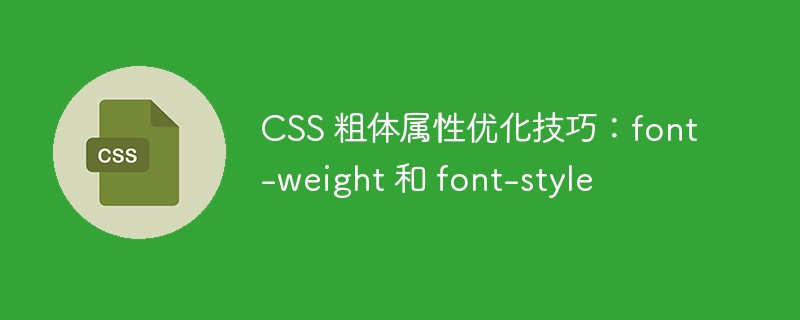Home >Web Front-end >CSS Tutorial >CSS bold property optimization tips: font-weight and font-style
CSS bold property optimization tips: font-weight and font-style
- WBOYWBOYWBOYWBOYWBOYWBOYWBOYWBOYWBOYWBOYWBOYWBOYWBOriginal
- 2023-10-20 19:19:471710browse

CSS bold attribute optimization skills: font-weight and font-style
When using CSS for web design, we often use the bold effect of fonts to highlight important text content. This effect can be achieved through the font-weight property in CSS. In addition, you can use the font-style attribute to add an italic effect to the text. In this article, we'll explore some optimization tips designed to help developers make better use of these two properties.
- Use relative weight values
In CSS, the font-weight attribute can be a keyword (such as "bold") or an absolute value (such as "700" ) or relative weight values (such as "bolder", "lighter"). Relative weight values are relative to the font weight of the parent element. If a font-weight value is not explicitly specified, the browser will choose a default font weight based on the element's default style. Therefore, using relative weight values can better adapt to the default style of different elements, making the bold effect more uniform.
For example, we can assign a relative weight value of "bolder" to all title elements:
h1, h2, h3, h4, h5, h6 {
font-weight: bolder;
}In this way, all title elements will be based on the font weight of their parent elements, and Will not be affected by default styles.
- Use font-weight values
In addition to keywords and relative weight values, the font-weight attribute can also use absolute values. Absolute values range from 100 to 900, where 400 represents normal font weight and 700 represents bold. Therefore, you can use specific numerical values of the font-weight property to control font weight more precisely.
For example, if we want to set the font of a specific element to be thinner than normal bold, we can use a value between 400 and 700, such as 500:
p {
font-weight: 500;
}In this way, the text in this paragraph will appear slightly thinner than the normal font.
- Use font-style to achieve italic effect
In addition to bold effect, italic effect is also an important part of font style. In CSS, the font-style property can be used to set the slant effect of text. Common values are "italic" (italic) and "normal" (normal).
For example, we can add an italic style to the quoted content:
blockquote {
font-style: italic;
}In this way, all quoted content will be displayed in italics.
To sum up, by optimizing the use of font-weight and font-style attributes, we can better control the thickness and slant effect of web fonts. Reasonable use of these two attributes can not only improve the visual effect of the web page, but also increase users' attention to important content.
The above is the detailed content of CSS bold property optimization tips: font-weight and font-style. For more information, please follow other related articles on the PHP Chinese website!

